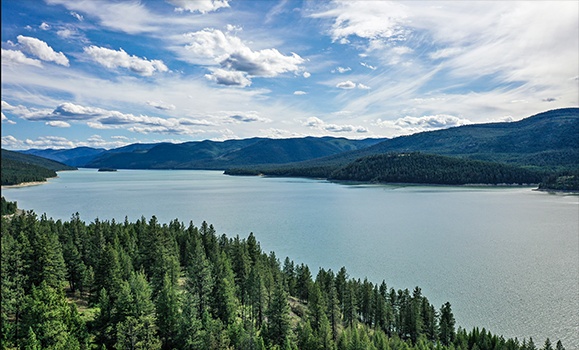, PhD Student, School for Resource & Environmental Studies,
Some of Canada’s biggest employers have a poor track record of abiding by environmental laws. When laws are broken corporate leaders don’t go to prison; instead, the company is fined. But the fines are rarely severe enough to scare them into changing their ways, let alone enough to make companies repair environmental damage or build a cleaner future.
Everyone has seen the headlines over the years: , and . The combined value of these three companies — , and (Husky’s parent corporation) — is over $75 billion.
Monetary penalties for breaking environmental laws . Yet, many companies are failing to maintain compliance and pollution continues to flow. This is .
Protecting water
Canada has an abundance of renewable surface water and groundwater — a that often gets taken for granted. Despite persistent and , water access in Canada is a privilege that many other regions of the world do not have.
Water pollution from natural resource extraction can hinder economic drivers like and , , and .
How fines are issued
There are two main options for fining big polluters: administrative penalties or court charges.
Administrative penalties proceed more quickly and have historically been used for relatively small fines. Several provinces including British Columbia and Ontario have recently upped maximum penalties to and respectively for corporations, depending on what law is broken.
Court charges are more common when federal law — such as the Fisheries Act — is also involved. Court convictions carry more social weight, allow for much bigger fines and threaten jail time. However, they can also take years and spending time in prison for harming the environment is an .
Flexibility in fine amounts and bogged down court systems have resulted in administrative penalties increasingly being favoured by regulators. For example, these penalties were nearly than court charges for industrial pollution under the B.C. Environmental Management Act from 2017 to 2022.
For many businesses, a hefty one-off fine for breaking an environmental law is an unsettling wake up call. Responsible employers reflect on this seriously and take tangible steps to reduce the chance of their operations harming the environment in the future.
But for wealthy repeat offenders, fines may be treated as nothing more than the . This is where the problem lies, and some of Canada’s richest corporations prove it.
Repeat water polluters in recent history
Teck Resources has been fined , and and for contaminating rivers and harming endangered fish in the Elk Valley, B.C. with toxic mining run-off from five nearby coal projects. The company has also been for toxic spills and leaks into the Columbia River from its nearby zinc and lead smelter.
The cost of these infractions has come to . While this may seem a hefty sum, it equals just 2 per cent of Teck’s dollar profits in 2023 alone.
In Québec, Rio Tinto has been fined on for illegal into rivers from its smelters and refineries. The company’s market cap is .
Oil giant Suncor Energy — in 2023 earnings — has a history of repeatedly polluting the Athabasca River with and , in addition to and during seabed drilling in offshore Newfoundland. None of Suncor’s fines related to water contamination has .
Scroll through any of these big polluters’ websites and you’ll find to sustainability and caring for the environment. But actions speak louder than words, and no amount of greenwashing lingo can erase the smears from a record of chronic non-compliance with environmental laws.
Serious policy changes to better protect water — — from repeat environmental offenders are warranted.
Potential paths forward
Laws work to protect the environment when they are . Amendments to the Clean Air Act in the United States in 1990 pushed polluters to innovate and resulted in a over the following 20 years despite a 33 per cent increase in manufacturing output.
Mimicking the successful regulatory overhauls of the past is no guarantee of success today. Still, there are several paths forward to reduce environmental degradation from natural resource extraction that are worth considering:
A new tier should be added to environmental laws with no maximum penalty, only applying to companies with a current market cap over a certain threshold — perhaps a billion dollars. This new penalty class would meaningfully punish the wealthiest of polluters without infringing on responsible actors.
Court prosecutions should be favoured over administrative penalties because they allow for bigger fines and posting to the which attract more public attention. Threats of public shaming and heftier penalties may spur environmental action from .
Stop-work orders and revoking operating permits through sanctions are but should occur . Recent efforts, like due to water contamination issues, from a polluter and forces clean up before shovels resume digging.
The importance of healthy water systems to Canadians cannot be overstated — it is time to get serious about how this resource is protected.
A wider problem
It’s too early to know the of the Baltimore bridge collapse. What is clear, however, is that while corporate entities look to , the American public will .
This most recent disaster is not unlike the sitting on Canadian taxpayers from a 2014 tailings dam failure at the Mount Polley Mine that spilled 24 million cubic metres of toxic waste into Fraser River salmon habitat. The company (Imperial Metals) was for the incident.
From Baltimore to the Fraser River, financial penalties to those who damage our environments remain pitifully low. Only by holding polluters truly to account can we effectively work to end environmental pollution both in Canada and around the world.![]()
This article is republished from under a Creative Commons license. Read the .

